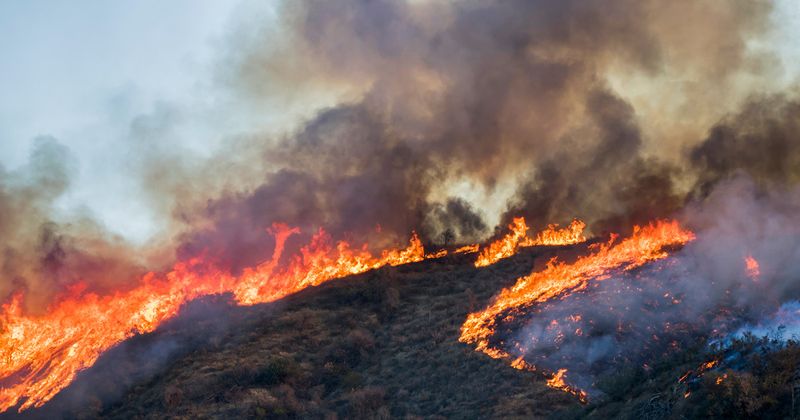November 07, 2023
4 min read
Key takeaways:
- Elevated levels of fine particulate matter raised the risk for cardiopulmonary ED visits.
- Morbidity due to wildfire pollution greatly impacted older adults, Native Americans and rural area residents.
Fine particulate matter from wildfires resulted in more cardiopulmonary ED visits among older adults, Native Americans and rural area residents, according to results published in American Journal of Respiratory and Critical Care Medicine.
“Wildfire smoke poses a growing threat as a source of air pollution, and many states, including California, are responding to this challenge by seeking ways to increase resilience and protect public health,” Ruwan Thilakaratne, MPH, PhD candidate in the division of epidemiology at University of California, Berkeley, and colleagues wrote. “An important step in this process is to understand how air pollution-related and smoke-related health burden has evolved over time and identify populations at increased risk of adverse health consequences because of heightened health susceptibility and increased smoke exposure.”

Using 2008 to 2016 data on approximately 37 million cardiorespiratory-related ED visits and hospitalizations in California, Thilakaratne and colleagues analyzed trends and disparities in fine particulate matter (PM2.5)-related and wildfire smoke PM2.5-related health burdens.
Researchers found the overall relationship between daily PM2.5 exposure and cardiopulmonary outcomes through patients’ home zip codes and then separated patients based on age, sex and race/ethnicity to evaluate the relationship among these subgroups.
Findings
Over the assessed years, burden caused by PM2.5 declined in an even fashion. In contrast, the health burden from wildfire-related PM2.5 differed according to the strength of the fire season each year, with an average of 5% to 6% of the burden attributable to PM2.5.
During 2008, the year with the most wildfire exposures, researchers observed that the smoke contributed 13% to 16% of the burden related to PM2.5 for asthma, COPD, respiratory disease and cardiovascular disease.
Researchers found that with every rise in PM2.5 by 10 g/m3, the risk for respiratory-related ED visits went up by 2.27% (95% CI, 2.14%-2.39%), the risk for asthma ED visits went up by 2.22% (95% CI, 2.04%-2.4%), the risk for COPD visits went up by 1.39% (95% CI, 1.08%-1.7%) and the risk for cardiovascular-related ED visits went up by 0.89% (95% CI, 0.8%-0.98%).
Of the four different cardiorespiratory reasons for ED visits, respiratory-related visits had the greatest relative risk and burden caused by PM2.5 (92 visits per 100,000 people per year), which made up 2.2% of the total respiratory burden, according to researchers.
The risk for hospitalization was also heightened with increasing PM2.5, with the highest risk again found for asthma (1.26%; 95% CI, 1%-1.53%) and respiratory-related hospitalizations (1.25%; 95% CI, 1.11%-1.4%). Similar to their ED percentage increase, the risk for COPD hospitalizations went up by 1.21% (95% CI, 0.98%-1.45%) and the risk for cardiovascular-related hospitalizations went up by 0.79% (95% CI, 0.69%-0.9%).
Across subgroups, researchers found that the risk for asthma ED visits with increasing PM2.5 was highest among those aged 65 years and older (3.29%; 95% CI, 2.72%-3.86%) and those who were Asian (3.42%; 95% CI, 2.47%-4.37%). The risk for respiratory-related ED visits was also highest among Asian individuals (3.4%; 95% CI, 2.79%-4.01%) when divided by race/ethnicity and among those aged 19 to 64 years (2.44%; 95% CI, 2.28%-2.61%) when divided by age groups.
Subgroup analysis did not show large differences in risk for visiting the ED for COPD or cardiovascular disease. However, Native Americans had a 5.67% (95% CI, 0.58%-11.03%) increased risk for a COPD ED visit with elevated levels of air pollution, which was much higher compared with other races/ethnicities.
Overall, those aged 65 years and older, Black individuals, Native American individuals, “other race” individuals and women had the most visits attributable to PM2.5.
Further, the greatest attributable fraction for asthma (0.16% of the total visit rate) and respiratory-related (0.17% of the total visit rate) ED visits during wildfire smoke days was found among Asian individuals, whereas the greatest attributable fraction for COPD (0.35% of the total visit rate) and CVD (0.1% of the total visit rate) was found among Native American individuals.
Researchers also found elevated smoke PM2.5 burden rates in rural vs. urban areas.
“In California, most existing disparities in health burden and total PM2.5 exposure are preserved in the smoke-related health burden, exacerbating existing environmental injustices,” Thilakaratne and colleagues wrote.
Protection practices
This work conducted by Thilakaratne and colleagues contributes to growing literature on the impact wildfire exposure has on public health, according to an accompanying editorial by Daniel C. Belz, MD, MPH, of the division of pulmonary and critical care medicine at The Johns Hopkins University School of Medicine, and colleagues.
With these findings, Belz and colleagues noted that interventions to help stop the spread of wildfires and their harmful emissions need to occur at all levels. The editorial authors outlined several practices individuals can adopt to protect themselves.
“At the individual level, potential interventions include staying indoors, wearing N95 masks when outdoors and using indoor air system filters or portable high-efficiency particulate air cleaners,” Belz and colleagues wrote. “Indoor PM2.5 concentration increases by more than three times during a wildfire, especially in low-income homes with poor-quality heating, ventilation and air conditioning systems and window and door sealing. Staying indoors decreases PM2.5 exposure by 33% to 76%, but this is likely insufficient to prevent excess exposure to wildfire smoke and for patients with cardiopulmonary disease.
“Further research is needed to understand the feasibility of deploying these interventions in real time in the wildfire setting and efficacy of preventing wildfire smoke-related hospitalizations,” Belz and colleagues added.
Reference:
Sources/Disclosures
Collapse
Disclosures:
Thilakaratne reports being a contractor with the California Department of Public Health while conducting this research. Please see the study for all other authors’ relevant financial disclosures. Belz reports receiving the 2020 American Thoracic Society Abstract Scholarship. The other editorial authors report no relevant financial disclosures.




